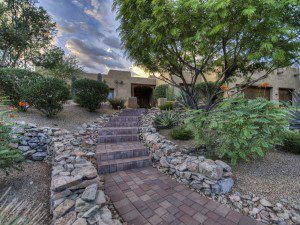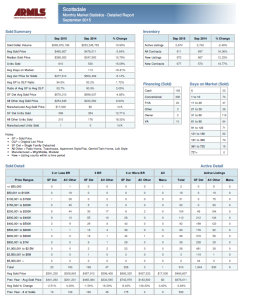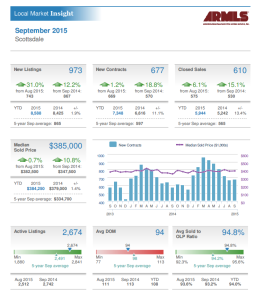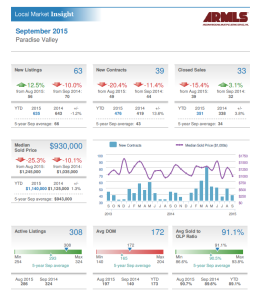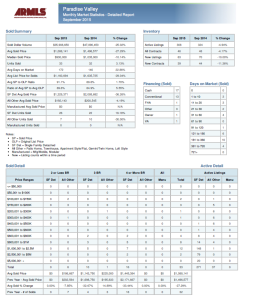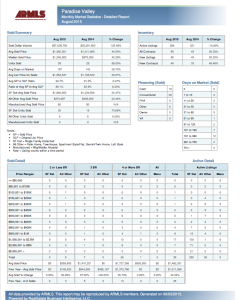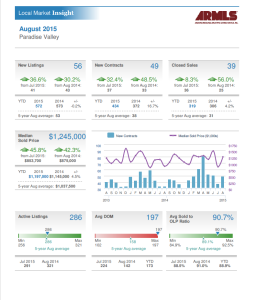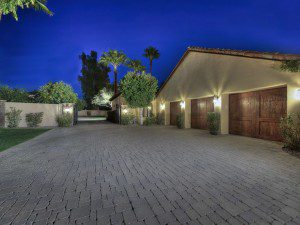 By Joe Szabo, Scottsdale Real Estate Team
In early May, homes sell fastest and for more money, according to the newest data. This is the new magic listing window for the country’s 25 biggest metro areas.
Weather and housing market dynamics affect the exact best window to sell in different areas, and this year, a low supply of homes on the market has pushed the window later in the spring. In Zillow’s first analysis of the best time to list, homes listed between mid-March and mid-April sold fastest and for the highest price. But the decline of the number of homes on the market has increased competition, so shoppers who start looking for a home in early spring may need to look at several homes and will often still be shopping a few months later. By May, some buyers may be anxious to get settled into a new home before the next school year — and will be more willing to pay a premium to close the deal.
For sellers hoping to sell quickly and get the maximum sale price for your home, the time to list is right in the first half of May. Nationally, homes sold May 1-15 sell about 18.5 days faster and for 1 percent more than the average listing. That means an average premium of $1,700 for the seller of a median home.
Today, Zillow has launched a new tool to personalize this data for individual sellers. The new Best Time to List feature estimates how much more money a seller can make by changing the listing date on their individual home. The tool is live for 71 million off-market homes, and registered Zillow users can find it by clicking the “Sell Your Home” on the home details page for an individual home. The methodology for the analysis, originally featured in “Zillow Talk: Rewriting the Rules of Real Estate,” is detailed on Zillow Research.
Please note that this Scottsdale Real Estate Blog is for informational purposes and not intended to take the place of a licensed Scottsdale Real Estate Agent. The Szabo Group offers first class real estate services to clients in the Scottsdale Greater Phoenix Metropolitan Area in the buying and selling of Luxury homes in Arizona. Award winning Realtors and Re/MAX top producers and best real estate agent for Luxury Homes in Scottsdale, The Szabo group delivers experience, knowledge, dedication and proven results. Contact Joe Szabo at 480.688.2020, [email protected] or visit www.scottsdalerealestateteam.com to find out more about Scottsdale Homes for Sale and Estates for Sale in Scottsdale and to search the Scottsdale MLS for Scottsdale Home Listings.
By Joe Szabo, Scottsdale Real Estate Team
In early May, homes sell fastest and for more money, according to the newest data. This is the new magic listing window for the country’s 25 biggest metro areas.
Weather and housing market dynamics affect the exact best window to sell in different areas, and this year, a low supply of homes on the market has pushed the window later in the spring. In Zillow’s first analysis of the best time to list, homes listed between mid-March and mid-April sold fastest and for the highest price. But the decline of the number of homes on the market has increased competition, so shoppers who start looking for a home in early spring may need to look at several homes and will often still be shopping a few months later. By May, some buyers may be anxious to get settled into a new home before the next school year — and will be more willing to pay a premium to close the deal.
For sellers hoping to sell quickly and get the maximum sale price for your home, the time to list is right in the first half of May. Nationally, homes sold May 1-15 sell about 18.5 days faster and for 1 percent more than the average listing. That means an average premium of $1,700 for the seller of a median home.
Today, Zillow has launched a new tool to personalize this data for individual sellers. The new Best Time to List feature estimates how much more money a seller can make by changing the listing date on their individual home. The tool is live for 71 million off-market homes, and registered Zillow users can find it by clicking the “Sell Your Home” on the home details page for an individual home. The methodology for the analysis, originally featured in “Zillow Talk: Rewriting the Rules of Real Estate,” is detailed on Zillow Research.
Please note that this Scottsdale Real Estate Blog is for informational purposes and not intended to take the place of a licensed Scottsdale Real Estate Agent. The Szabo Group offers first class real estate services to clients in the Scottsdale Greater Phoenix Metropolitan Area in the buying and selling of Luxury homes in Arizona. Award winning Realtors and Re/MAX top producers and best real estate agent for Luxury Homes in Scottsdale, The Szabo group delivers experience, knowledge, dedication and proven results. Contact Joe Szabo at 480.688.2020, [email protected] or visit www.scottsdalerealestateteam.com to find out more about Scottsdale Homes for Sale and Estates for Sale in Scottsdale and to search the Scottsdale MLS for Scottsdale Home Listings.Time Your Listing in the Magic Window to Sell Faster and for More Money By Joe Szabo, Scottsdale Real Estate Team
 By Joe Szabo, Scottsdale Real Estate Team
In early May, homes sell fastest and for more money, according to the newest data. This is the new magic listing window for the country’s 25 biggest metro areas.
Weather and housing market dynamics affect the exact best window to sell in different areas, and this year, a low supply of homes on the market has pushed the window later in the spring. In Zillow’s first analysis of the best time to list, homes listed between mid-March and mid-April sold fastest and for the highest price. But the decline of the number of homes on the market has increased competition, so shoppers who start looking for a home in early spring may need to look at several homes and will often still be shopping a few months later. By May, some buyers may be anxious to get settled into a new home before the next school year — and will be more willing to pay a premium to close the deal.
For sellers hoping to sell quickly and get the maximum sale price for your home, the time to list is right in the first half of May. Nationally, homes sold May 1-15 sell about 18.5 days faster and for 1 percent more than the average listing. That means an average premium of $1,700 for the seller of a median home.
Today, Zillow has launched a new tool to personalize this data for individual sellers. The new Best Time to List feature estimates how much more money a seller can make by changing the listing date on their individual home. The tool is live for 71 million off-market homes, and registered Zillow users can find it by clicking the “Sell Your Home” on the home details page for an individual home. The methodology for the analysis, originally featured in “Zillow Talk: Rewriting the Rules of Real Estate,” is detailed on Zillow Research.
Please note that this Scottsdale Real Estate Blog is for informational purposes and not intended to take the place of a licensed Scottsdale Real Estate Agent. The Szabo Group offers first class real estate services to clients in the Scottsdale Greater Phoenix Metropolitan Area in the buying and selling of Luxury homes in Arizona. Award winning Realtors and Re/MAX top producers and best real estate agent for Luxury Homes in Scottsdale, The Szabo group delivers experience, knowledge, dedication and proven results. Contact Joe Szabo at 480.688.2020, [email protected] or visit www.scottsdalerealestateteam.com to find out more about Scottsdale Homes for Sale and Estates for Sale in Scottsdale and to search the Scottsdale MLS for Scottsdale Home Listings.
By Joe Szabo, Scottsdale Real Estate Team
In early May, homes sell fastest and for more money, according to the newest data. This is the new magic listing window for the country’s 25 biggest metro areas.
Weather and housing market dynamics affect the exact best window to sell in different areas, and this year, a low supply of homes on the market has pushed the window later in the spring. In Zillow’s first analysis of the best time to list, homes listed between mid-March and mid-April sold fastest and for the highest price. But the decline of the number of homes on the market has increased competition, so shoppers who start looking for a home in early spring may need to look at several homes and will often still be shopping a few months later. By May, some buyers may be anxious to get settled into a new home before the next school year — and will be more willing to pay a premium to close the deal.
For sellers hoping to sell quickly and get the maximum sale price for your home, the time to list is right in the first half of May. Nationally, homes sold May 1-15 sell about 18.5 days faster and for 1 percent more than the average listing. That means an average premium of $1,700 for the seller of a median home.
Today, Zillow has launched a new tool to personalize this data for individual sellers. The new Best Time to List feature estimates how much more money a seller can make by changing the listing date on their individual home. The tool is live for 71 million off-market homes, and registered Zillow users can find it by clicking the “Sell Your Home” on the home details page for an individual home. The methodology for the analysis, originally featured in “Zillow Talk: Rewriting the Rules of Real Estate,” is detailed on Zillow Research.
Please note that this Scottsdale Real Estate Blog is for informational purposes and not intended to take the place of a licensed Scottsdale Real Estate Agent. The Szabo Group offers first class real estate services to clients in the Scottsdale Greater Phoenix Metropolitan Area in the buying and selling of Luxury homes in Arizona. Award winning Realtors and Re/MAX top producers and best real estate agent for Luxury Homes in Scottsdale, The Szabo group delivers experience, knowledge, dedication and proven results. Contact Joe Szabo at 480.688.2020, [email protected] or visit www.scottsdalerealestateteam.com to find out more about Scottsdale Homes for Sale and Estates for Sale in Scottsdale and to search the Scottsdale MLS for Scottsdale Home Listings.
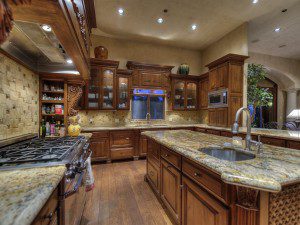 By
By 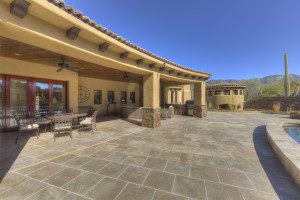 By
By 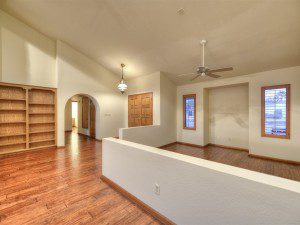 By
By 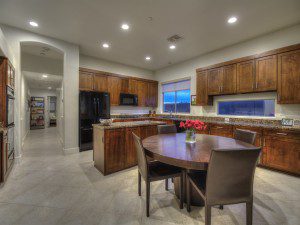
 People used to get there with second jobs, but lenders don’t see this as much since the recession.
“Instead, what you see is somebody graduates from college, they move back home to pay off debt and save money, and they work 50, 60 hours a week at the job that they found,” said Staci Titsworth, a regional manager for PNC Mortgage in Pittsburgh.
There are also more double-income households, and more first-time buyers waiting to buy homes where they can stay more than 5 years and possibly raise families, she said.
People are also coming in below 20 percent, which typically requires paying mortgage insurance.
Even with mortgage insurance tacked on, people tend to have lower monthly payments for mortgages than for rent. Indeed, homeowners in general can expect to spend about 15 percent of their monthly income on mortgage payments (without mortgage insurance) for a median-valued home, while renters can expect to spend 30 percent on rent.
Borrowers in pricey markets have taken the lower down payment route for years.
That’s how Sara Clarke, an editor at U.S. News & World Report, and her husband landed their first home: a townhouse in Alexandria, VA, that cost $299,500. They put down 5 percent, money saved from a childhood paper route and fast-food jobs, plus a little help from a relative.
By the time they sold it about 10 years later, they had accrued the 20 percent down payment they needed for a single-family home in Fairfax County. They even had money left over to replenish a savings account depleted by upgrades on their first kitchen, bathrooms, roof and “redoing everything we could redo.”
Assistance from parents remains a common way to get a foot in the door of your own home. Loans and gifts from family and friends rose from 8 percent to 21 percent during the recession, and was down to 13 percent last year.
JPMorgan Chase has also seen first-time buyers becoming more disciplined about spending and tapping into 401(k)s, said Sean Grzebin, the bank’s head of retail mortgage lending.
Check out Zillow Research for more on down payments, rents and the housing market in general.
People used to get there with second jobs, but lenders don’t see this as much since the recession.
“Instead, what you see is somebody graduates from college, they move back home to pay off debt and save money, and they work 50, 60 hours a week at the job that they found,” said Staci Titsworth, a regional manager for PNC Mortgage in Pittsburgh.
There are also more double-income households, and more first-time buyers waiting to buy homes where they can stay more than 5 years and possibly raise families, she said.
People are also coming in below 20 percent, which typically requires paying mortgage insurance.
Even with mortgage insurance tacked on, people tend to have lower monthly payments for mortgages than for rent. Indeed, homeowners in general can expect to spend about 15 percent of their monthly income on mortgage payments (without mortgage insurance) for a median-valued home, while renters can expect to spend 30 percent on rent.
Borrowers in pricey markets have taken the lower down payment route for years.
That’s how Sara Clarke, an editor at U.S. News & World Report, and her husband landed their first home: a townhouse in Alexandria, VA, that cost $299,500. They put down 5 percent, money saved from a childhood paper route and fast-food jobs, plus a little help from a relative.
By the time they sold it about 10 years later, they had accrued the 20 percent down payment they needed for a single-family home in Fairfax County. They even had money left over to replenish a savings account depleted by upgrades on their first kitchen, bathrooms, roof and “redoing everything we could redo.”
Assistance from parents remains a common way to get a foot in the door of your own home. Loans and gifts from family and friends rose from 8 percent to 21 percent during the recession, and was down to 13 percent last year.
JPMorgan Chase has also seen first-time buyers becoming more disciplined about spending and tapping into 401(k)s, said Sean Grzebin, the bank’s head of retail mortgage lending.
Check out Zillow Research for more on down payments, rents and the housing market in general.
